Research Progress of Event Intelligent Perception Based on DAS
Abstract
1. Introduction
2. Distributed Acoustic Sensing
2.1. Sensing Principles
2.2. System Composition
2.3. Performance Index
- (1)
- Sensitivity
- (2)
- Spatial Resolution
- (3)
- Frequency Response Range
- (4)
- Sensing Distance
3. Event Perception Technology in DAS
3.1. Traditional Machine Learning
3.2. Deep Learning
3.3. Hybrid Architecture of Machine Learning and Deep Learning
3.4. Intelligent Sensing Technology
3.5. Comparative Analysis of Model Suitability Across Operational Scenarios
3.5.1. Low-Sample Environments
3.5.2. High-Noise Conditions
3.5.3. Real-Time Processing
3.5.4. Multi-Event Classification
4. Application Fields
4.1. Urban Road and Transport Railway Monitoring
4.2. Perimeter Security Intrusion Detection
4.3. Infrastructure Monitoring
4.4. Earthquake Monitoring
4.5. Oil Production Surveillance
5. Challenge
5.1. Data Scarcity
5.2. Complex Environmental Interference
6. Conclusions
Author Contributions
Funding
Institutional Review Board Statement
Informed Consent Statement
Data Availability Statement
Conflicts of Interest
References
- Shao, J.; Wang, Y.; Zhang, C.; Zhang, X.; Zhang, Y. Near-surface structure investigation using ambient noise in the water environment recorded by fiber-optic distributed acoustic sensing. Remote Sens. 2023, 15, 3329. [Google Scholar] [CrossRef]
- Vidaña-Vila, E.; Navarro, J.; Borda-Fortuny, C.; Stowell, D.; Alsina-Pagès, R.M. Low-cost distributed acoustic sensor network for real-time urban sound monitoring. Electronics 2020, 9, 2119. [Google Scholar] [CrossRef]
- Hilal, A.R.; Sayedelahl, A.; Tabibiazar, A.; Kamel, M.S.; Basir, O.A. A distributed sensor management for large-scale IoT indoor acoustic surveillance. Future Gener. Comput. Syst. 2018, 86, 1170–1184. [Google Scholar] [CrossRef]
- Bin, K.; Lin, J.; Tong, X.; Zhang, X.; Wang, J.; Luo, S. Moving target recognition with seismic sensing: A review. Measurement 2021, 181, 109584. [Google Scholar] [CrossRef]
- Chen, X.; Zhou, Z.; Wang, N.; Wang, W.; Xing, K.; Jiang, Y.; Liu, A. Target Recognition and Localization Based on Acoustic Vibration Sensors. In Proceedings of the International Conference on Autonomous Unmanned Systems, Shenyang, China, 19–21 September 2024; pp. 355–366. [Google Scholar]
- Algobail, A.; Soudani, A.; Alahmadi, S. Energy-efficient scheme for target recognition and localization in wireless acoustic sensor networks. Int. J. Distrib. Sens. Netw. 2019, 15, 1550147719891406. [Google Scholar] [CrossRef]
- Farghal, N.S.; Saunders, J.K.; Parker, G.A. The potential of using fiber optic distributed acoustic sensing (DAS) in earthquake early warning applications. Bull. Seismol. Soc. Am. 2022, 112, 1416–1435. [Google Scholar] [CrossRef]
- Kumar, P.; Kumar, P.; Priyadarshini, P. Underwater acoustic sensor network for early warning generation. In Proceedings of the 2012 Oceans, Hampton Roads, VA, USA, 14–19 October 2012; pp. 1–6. [Google Scholar]
- Katakami, S.; Korenaga, M.; Iwata, N.; Araki, E.; Takahashi, N.; Noda, S. Immediate and High-Precision Hypocentral Determination for Earthquake Early Warning Applications Using Distributed Acoustic Sensing. Bull. Seismol. Soc. Am. 2025, 115, 174–190. [Google Scholar] [CrossRef]
- Fouda, B.M.T.; Yang, B.; Han, D.; An, B. Pattern recognition of optical fiber vibration signal of the submarine cable for its safety. IEEE Sens. J. 2020, 21, 6510–6519. [Google Scholar] [CrossRef]
- Jia, H.; Liang, S.; Lou, S.; Sheng, X. A k-Nearest Neighbor Algorithm-Based Near Category Support Vector Machine Method for Event Identification of φ-OTDR. IEEE Sens. J. 2019, 19, 3683–3689. [Google Scholar] [CrossRef]
- Wu, H.; Chen, J.; Liu, X.; Xiao, Y.; Wang, M.; Zheng, Y.; Rao, Y. One-dimensional CNN-based intelligent recognition of vibrations in pipeline monitoring with DAS. J. Light. Technol. 2019, 37, 4359–4366. [Google Scholar] [CrossRef]
- Tejedor, J.; Macias-Guarasa, J.; Martins, H.F.; Martin-Lopez, S.; Gonzalez-Herraez, M. A contextual GMM-HMM smart fiber optic surveillance system for pipeline integrity threat detection. J. Light. Technol. 2019, 37, 4514–4522. [Google Scholar] [CrossRef]
- Lyu, C.; Huo, Z.; Cheng, X.; Jiang, J.; Alimasi, A.; Liu, H. Distributed optical fiber sensing intrusion pattern recognition based on GAF and CNN. J. Light. Technol. 2020, 38, 4174–4182. [Google Scholar] [CrossRef]
- Wu, H.; Yang, S.; Liu, X.; Xu, C.; Lu, H.; Wang, C.; Qin, K.; Wang, Z.; Rao, Y.; Olaribigbe, A.O. Simultaneous extraction of multi-scale structural features and the sequential information with an end-to-end mCNN-HMM combined model for fiber distributed acoustic sensor. J. Light. Technol. 2021, 39, 6606–6616. [Google Scholar] [CrossRef]
- Ma, Y.; Song, Y.; Song, Q.; Xiao, Q.; Jia, B. MI-SI based distributed optical fiber sensor for no-blind zone location and pattern recognition. J. Light. Technol. 2022, 40, 3022–3030. [Google Scholar] [CrossRef]
- Zhao, X.; Sun, H.; Lin, B.; Zhao, H.; Niu, Y.; Zhong, X.; Wang, Y.; Zhao, Y.; Meng, F.; Ding, J. Markov transition fields and deep learning-based event-classification and vibration-frequency measurement for φ-OTDR. IEEE Sens. J. 2021, 22, 3348–3357. [Google Scholar] [CrossRef]
- Fernandez-Carabantes, J.; Titos, M.; D’Auria, L.; Garcia, J.; Garcia, L.; Benitez, C. RNN-DAS: A New Deep Learning Approach for Detection and Real-Time Monitoring of Volcano-Tectonic Events Using Distributed Acoustic Sensing. arXiv 2025, arXiv:2503.11622. [Google Scholar]
- Rahman, M.A.; Jamal, S.; Taheri, H. A Deep LSTM-Sliding Window Model for Real-Time Monitoring of Railroad Conditions Using Distributed Acoustic Sensing (DAS). In Proceedings of the ASME/IEEE Joint Rail Conference, Columbia, SC, USA, 13–15 May 2024; p. V001T001A005. [Google Scholar]
- Wybo, J.-L. Track circuit reliability assessment for preventing railway accidents. Saf. Sci. 2018, 110, 268–275. [Google Scholar] [CrossRef]
- Peng, F.; Duan, N.; Rao, Y.-J.; Li, J. Real-time position and speed monitoring of trains using phase-sensitive OTDR. IEEE Photonics Technol. Lett. 2014, 26, 2055–2057. [Google Scholar] [CrossRef]
- He, M.; Feng, L.; Fan, J. A method for real-time monitoring of running trains using Φ-OTDR and the improved Canny. Optik 2019, 184, 356–363. [Google Scholar] [CrossRef]
- Chen, M.; Ding, H.; Liu, M.; Zhu, Z.; Rui, D.; Chen, Y.; Xu, F. Vehicle operation status monitoring based on distributed acoustic sensor. Sensors 2023, 23, 8799. [Google Scholar] [CrossRef]
- Zhang, G.; Song, Z.; Osotuyi, A.G.; Lin, R.; Chi, B. Railway traffic monitoring with trackside fiber-optic cable by distributed acoustic sensing Technology. Front. Earth Sci. 2022, 10, 990837. [Google Scholar] [CrossRef]
- Juarez, J.C.; Maier, E.W.; Choi, K.N.; Taylor, H.F. Distributed fiber-optic intrusion sensor system. J. Light. Technol. 2005, 23, 2081–2087. [Google Scholar] [CrossRef]
- Mahmoud, S.S.; Katsifolis, J. Elimination of rain-induced nuisance alarms in distributed fiber optic perimeter intrusion detection systems. In Proceedings of the Fiber Optic Sensors and Applications VI, Orlando, FL, USA, 15–17 April 2009; pp. 38–48. [Google Scholar]
- Luo, K.; Wang, B.; Guo, N.; Yu, K.; Yu, C.; Lu, C. Enhancing SNR by anisotropic diffusion for Brillouin distributed optical fiber sensors. J. Light. Technol. 2020, 38, 5844–5852. [Google Scholar] [CrossRef]
- Ružička, M.; Münster, P.; Dejdar, P.; Jablončík, L. Distributed optical fiber acoustic sensing system for perimeter security. Secur. Future 2021, 5, 150–152. [Google Scholar]
- Cheng, L.; Jansen, R.; Burggraaf, H.; Jong, W.; Toet, P.; Doppenberg, E. Dynamic load monitoring of a concrete bridge using a fiber optic distributed acoustic sensing (DAS) system. In Proceedings of the 5th International Conference on Smart Monitoring, Assessment and Rehabilitation of Civil Structures, Potsdam, Germany, 27–29 August 2019; pp. 27–29. [Google Scholar]
- Fernández-Ruiz, M.R.; Garcia-Ruiz, A.; Martins, H.F.; Pastor-Graells, J.; Martin-Lopez, S.; Gonzalez-Herraez, M. Protecting fiber-optic links from third party intrusion using distributed acoustic sensors. In Proceedings of the 2017 19th International Conference on Transparent Optical Networks (ICTON), Girona, Spain, 2–6 July 2017; pp. 1–4. [Google Scholar]
- Tejedor, J.; Macias-Guarasa, J.; Martins, H.F.; Martin-Lopez, S.; Gonzalez-Herraez, M. A multi-position approach in a smart fiber-optic surveillance system for pipeline integrity threat detection. Electronics 2021, 10, 712. [Google Scholar] [CrossRef]
- Webster, P.; Wall, J.; Perkins, C.; Molenaar, M. Micro-seismic detection using distributed acoustic sensing. In SEG Technical Program Expanded Abstracts 2013; Society of Exploration Geophysicists: Houston, TX, USA, 2013; pp. 2459–2463. [Google Scholar]
- Dou, S.; Lindsey, N.; Wagner, A.M.; Daley, T.M.; Freifeld, B.; Robertson, M.; Peterson, J.; Ulrich, C.; Martin, E.R.; Ajo-Franklin, J.B. Distributed acoustic sensing for seismic monitoring of the near surface: A traffic-noise interferometry case study. Sci. Rep. 2017, 7, 11620. [Google Scholar] [CrossRef]
- Fernández-Ruiz, M.R.; Soto, M.A.; Williams, E.F.; Martin-Lopez, S.; Zhan, Z.; Gonzalez-Herraez, M.; Martins, H.F. Distributed acoustic sensing for seismic activity monitoring. APL Photonics 2020, 5, 030901. [Google Scholar] [CrossRef]
- Fang, G.; Li, Y.E.; Zhao, Y.; Martin, E.R. Urban near-surface seismic monitoring using distributed acoustic sensing. Geophys. Res. Lett. 2020, 47, e2019GL086115. [Google Scholar] [CrossRef]
- Fernández-Ruiz, M.R.; Martins, H.F.; Williams, E.F.; Becerril, C.; Magalhães, R.; Costa, L.; Martin-Lopez, S.; Jia, Z.; Zhan, Z.; González-Herráez, M. Seismic monitoring with distributed acoustic sensing from the near-surface to the deep oceans. J. Light. Technol. 2022, 40, 1453–1463. [Google Scholar] [CrossRef]
- Xie, T.; Zhang, C.-C.; Shi, B.; Wang, Z.; Zhang, S.-S.; Yin, J. Seismic monitoring of rockfalls using distributed acoustic sensing. Eng. Geol. 2023, 325, 107285. [Google Scholar] [CrossRef]
- Barnoski, M.; Jensen, S. Fiber waveguides: A novel technique for investigating attenuation characteristics. Appl. Opt. 1976, 15, 2112–2115. [Google Scholar] [CrossRef]
- Kurashima, T.; Horiguchi, T.; Izumita, H.; Furukawa, S.-i.; Koyamada, Y. Brillouin optical-fiber time domain reflectometry. IEICE Trans. Commun. 1993, 76, 382–390. [Google Scholar]
- Corsi, F.; Galtarossa, A.; Palmieri, L. Polarization mode dispersion characterization of single-mode optical fiber using backscattering technique. J. Light. Technol. 1998, 16, 1832. [Google Scholar] [CrossRef]
- Li, Q.; Zhang, C.; Li, L.; Zhong, X. Localization mechanisms and location methods of the disturbance sensor based on phase-sensitive OTDR. Optik 2014, 125, 2099–2103. [Google Scholar] [CrossRef]
- Boyd, R.W.; Gaeta, A.L.; Giese, E. Nonlinear optics. In Springer Handbook of Atomic, Molecular, and Optical Physics; Springer: Berlin/Heidelberg, Germany, 2008; pp. 1097–1110. [Google Scholar]
- Milonni, P.W.; Eberly, J.H. Laser Physics; John Wiley & Sons: Hoboken, NJ, USA, 2010. [Google Scholar]
- Fabelinskii, I.L. Molecular Scattering of Light; Springer Science & Business Media: Berlin/Heidelberg, Germany, 2012. [Google Scholar]
- Horiguchi, T.; Shimizu, K.; Kurashima, T.; Tateda, M.; Koyamada, Y. Development of a distributed sensing technique using Brillouin scattering. J. Light. Technol. 1995, 13, 1296–1302. [Google Scholar] [CrossRef]
- Gardiner, D.J. Introduction to Raman scattering. In Practical Raman Spectroscopy; Springer: Berlin/Heidelberg, Germany, 1989; pp. 1–12. [Google Scholar]
- Lindsey, N.J.; Rademacher, H.; Ajo-Franklin, J.B. On the Broadband Instrument Response of Fiber-Optic DAS Arrays. J. Geophys. Res. Solid Earth 2020, 125, e2019JB018145. [Google Scholar] [CrossRef]
- Lévesque, L. Nyquist sampling theorem: Understanding the illusion of a spinning wheel captured with a video camera. Phys. Educ. 2014, 49, 697. [Google Scholar] [CrossRef]
- Wiesmeyr, C.; Litzenberger, M.; Waser, M.; Papp, A.; Garn, H.; Neunteufel, G.; Döller, H. Real-time train tracking from distributed acoustic sensing data. Appl. Sci. 2020, 10, 448. [Google Scholar] [CrossRef]
- Abufana, S.A.; Dalveren, Y.; Aghnaiya, A.; Kara, A. Variational mode decomposition-based threat classification for fiber optic distributed acoustic sensing. IEEE Access 2020, 8, 100152–100158. [Google Scholar] [CrossRef]
- Cai, Y.; Xu, T.; Ma, J.; Yan, W. Train detection and classification using distributed fiber-optic acoustic sensing. Interpretation 2021, 9, SJ13–SJ22. [Google Scholar] [CrossRef]
- Zhang, T.; Zhang, C.-C.; Shi, B.; Chen, Z.; Zhao, X.; Wang, Z. Artificial intelligence-based distributed acoustic sensing enables automated identification of wire breaks in prestressed concrete cylinder pipe. J. Appl. Geophys. 2024, 224, 105378. [Google Scholar] [CrossRef]
- Wu, H.; Liu, X.; Xiao, Y.; Rao, Y. A dynamic time sequence recognition and knowledge mining method based on the hidden Markov models (HMMs) for pipeline safety monitoring with Φ-OTDR. J. Light. Technol. 2019, 37, 4991–5000. [Google Scholar] [CrossRef]
- Li, W.; He, L.; Li, Z.; Wan, Y. Detection of Track Bed Defects Based on Fibre Optic Sensor Signals and an Improved Hidden Markov Model. Electronics 2024, 13, 2504. [Google Scholar] [CrossRef]
- Wang, X.; Liu, Y.; Liang, S.; Zhang, W.; Lou, S. Event identification based on random forest classifier for Φ-OTDR fiber-optic distributed disturbance sensor. Infrared Phys. Technol. 2019, 97, 319–325. [Google Scholar] [CrossRef]
- Zhang, T.-Y.; Shi, B.; Zhang, C.-C.; Xie, T.; Yin, J.; Li, J.-P. Tunnel disturbance events monitoring and recognition with distributed acoustic sensing (DAS). In Proceedings of the ISRM International Symposium-Asian Rock Mechanics Symposium, Beijing, China, 21–25 October 2021; p. ISRM-ARMS11-2021-572. [Google Scholar]
- Kou, X.-W.; Du, Q.-G.; Huang, L.-T.; Wang, H.-H.; Li, Z.-Y. Highway vehicle detection based on distributed acoustic sensing. Opt. Express 2024, 32, 27068–27080. [Google Scholar] [CrossRef]
- Wijaya, H.; Rajeev, P.; Gad, E.; Vivekanantham, R. Automatic fault detection system for mining conveyor using distributed acoustic sensor. Measurement 2022, 187, 110330. [Google Scholar] [CrossRef]
- Gietz, H.; Sharma, J.; Tyagi, M. Machine Learning for Automated Sand Transport Monitoring in a Pipeline Using Distributed Acoustic Sensor Data. IEEE Sens. J. 2024, 24, 22444–22457. [Google Scholar] [CrossRef]
- Tejedor, J.; Macias-Guarasa, J.; Martins, H.F.; Piote, D.; Pastor-Graells, J.; Martin-Lopez, S.; Corredera, P.; Gonzalez-Herraez, M. A novel fiber optic based surveillance system for prevention of pipeline integrity threats. Sensors 2017, 17, 355. [Google Scholar] [CrossRef]
- Aslangul, S.A. Detecting Tunnels for Border Security based on Fiber Optical Distributed Acoustic Sensor Data using DBSCAN. In Proceedings of the Sensornets, Valletta, Malta, 28–29 February 2020; pp. 78–84. [Google Scholar]
- Li, T.; Lin, J.; Zhao, X. Research on the multi-source vibration identification method of distributed fiber sensing based on improved fast independent component analysis. Opt. Express 2025, 33, 98–118. [Google Scholar] [CrossRef] [PubMed]
- Wang, S.; Liu, F.; Liu, B. Research on application of deep convolutional network in high-speed railway track inspection based on distributed fiber acoustic sensing. Opt. Commun. 2021, 492, 126981. [Google Scholar] [CrossRef]
- Wu, H.; Zhou, B.; Zhu, K.; Shang, C.; Tam, H.-Y.; Lu, C. Pattern recognition in distributed fiber-optic acoustic sensor using an intensity and phase stacked convolutional neural network with data augmentation. Opt. Express 2021, 29, 3269–3283. [Google Scholar] [CrossRef]
- Hernández, P.D.; Ramírez, J.A.; Soto, M.A. Deep-learning-based earthquake detection for fiber-optic distributed acoustic sensing. J. Light. Technol. 2021, 40, 2639–2650. [Google Scholar] [CrossRef]
- Wang, S.; Liu, F.; Liu, B. Semi-supervised deep learning in high-speed railway track detection based on distributed fiber acoustic sensing. Sensors 2022, 22, 413. [Google Scholar] [CrossRef]
- Chiang, C.-Y.; Jaber, M.; Chai, K.K.; Loo, J. Distributed acoustic sensor systems for vehicle detection and classification. IEEE Access 2023, 11, 31293–31303. [Google Scholar] [CrossRef]
- Hu, X.; Qiu, G.; Karimi, H.R.; Zhang, D. TFF-CNN: Distributed optical fiber sensing intrusion detection framework based on two-dimensional multi-features. Neurocomputing 2024, 564, 126959. [Google Scholar] [CrossRef]
- Dong, L.; Zhao, W.; Huang, S.; Zhang, C.; Zhang, Y.; Kong, X.; Shang, Y.; Liu, G.; Yao, C.; Liu, S. Distributed fiber optic acoustic sensing system intrusion full event recognition based on 1-D MFEWnet. Phys. Scr. 2024, 99, 045506. [Google Scholar] [CrossRef]
- Wu, H.; Liu, X.; Wang, X.; Wu, Y.; Liu, Y.; Wang, Y. Multi-Dimensional Information Extraction and Utilization in Smart Fiber-Optic Distributed Acoustic Sensor (sDAS). J. Light. Technol. 2024, 42, 6967–6980. [Google Scholar] [CrossRef]
- Duan, Y.; Liang, L.; Tong, X.; Luo, B.; Cheng, B. Application of pipeline leakage detection based on distributed optical fiber acoustic sensor system and convolutional neural network. J. Phys. D Appl. Phys. 2023, 57, 105102. [Google Scholar] [CrossRef]
- Zeng, Y.; Zhang, J.; Zhong, Y.; Deng, L.; Wang, M. STNet: A time-frequency analysis-based intrusion detection network for distributed optical fiber acoustic sensing systems. Sensors 2024, 24, 1570. [Google Scholar] [CrossRef]
- Han, S.; Huang, M.-F.; Li, T.; Fang, J.; Jiang, Z.; Wang, T. Deep learning-based intrusion detection and impulsive event classification for distributed acoustic sensing across telecom networks. J. Light. Technol. 2024, 42, 4167–4176. [Google Scholar] [CrossRef]
- Li, S.; Peng, R.; Liu, Z.; Liu, X. Perimeter monitoring of urban buried pipeline threated by construction activities based on distributed fiber optic sensing and real-time object detection. Opt. Express 2024, 32, 2590–2606. [Google Scholar] [CrossRef]
- Stork, A.L.; Baird, A.F.; Horne, S.A.; Naldrett, G.; Lapins, S.; Kendall, J.-M.; Wookey, J.; Verdon, J.P.; Clarke, A.; Williams, A. Application of machine learning to microseismic event detection in distributed acoustic sensing data. Geophysics 2020, 85, KS149–KS160. [Google Scholar] [CrossRef]
- Li, H.; Gao, R.; Sun, F.; Wang, Y.; Ma, B. A Prestressed Concrete Cylinder Pipe Broken Wire Detection Algorithm Based on Improved YOLOv5. Sensors 2025, 25, 977. [Google Scholar] [CrossRef] [PubMed]
- Zhang, H.; Wang, C.; Zhang, F.; Jiang, S.; Sun, Z.; Wang, X.; Duan, Z.; Gao, F.; Liu, Z. Distributed acoustic sensing signal event recognition and localization based on improved YOLOv7. J. Phys. Conf. Ser. 2024, 2822, 012085. [Google Scholar] [CrossRef]
- Wang, Y.-y.; Zhao, S.-w.; Wang, C.; Zhang, H.-b.; Li, X.-d. Intelligent detection and recognition of multi-vibration events based on distributed acoustic sensor and improved YOLOv8 model. Opt. Fiber Technol. 2024, 84, 103706. [Google Scholar] [CrossRef]
- Ma, B.; Gao, R.; Zhang, J.; Zhu, X. A yolox-based automatic monitoring approach of broken wires in prestressed concrete cylinder pipe using fiber-optic distributed acoustic sensors. Sensors 2023, 23, 2090. [Google Scholar] [CrossRef]
- Li, Z.; Zhang, J.; Wang, M.; Chai, J.; Wu, Y.; Peng, F. An anti-noise ϕ-OTDR based distributed acoustic sensing system for high-speed railway intrusion detection. Laser Phys. 2020, 30, 085103. [Google Scholar] [CrossRef]
- Li, Z.; Zhang, J.; Wang, M.; Zhong, Y.; Peng, F. Fiber distributed acoustic sensing using convolutional long short-term memory network: A field test on high-speed railway intrusion detection. Opt. Express 2020, 28, 2925–2938. [Google Scholar] [CrossRef]
- Wang, M.; Feng, H.; Qi, D.; Du, L.; Sha, Z. φ-OTDR pattern recognition based on CNN-LSTM. Optik 2023, 272, 170380. [Google Scholar] [CrossRef]
- Bai, Y.; Xing, J.; Xie, F.; Liu, S.; Li, J. Detection and identification of external intrusion signals from 33 km optical fiber sensing system based on deep learning. Opt. Fiber Technol. 2019, 53, 102060. [Google Scholar] [CrossRef]
- Li, Z. Exploiting CNN-BiLSTM Model for Distributed Acoustic Sensing Event Recognition. In Proceedings of the 2024 International Conference on Artificial Intelligence and Communication (ICAIC 2024), Davos, Switzerland, 10–11 July 2024; pp. 333–341. [Google Scholar]
- Rahman, M.A. Railroad Condition Monitoring Using Distributed Acoustic Sensing and Deep Learning Techniques. Master’s Thesis, Georgia Southern University, Georgia, GA, USA, 2024. [Google Scholar]
- Rahman, M.A.; Kim, J.; Dababneh, F.; Taheri, H. Railroad condition monitoring with distributed acoustic sensing: An investigation of deep learning methods for condition detection. J. Appl. Remote Sens. 2024, 18, 016512. [Google Scholar] [CrossRef]
- Zhou, Y.; Yeoh, J.K.; Li, Y.E.; Solihin, W. Large scale indoor occupant tracking using distributed acoustic sensing and machine learning. Build. Environ. 2024, 247, 111005. [Google Scholar] [CrossRef]
- He, T.; Zhang, S.; Li, H.; Zeng, Z.; Chen, J.; Yan, Z.; Liu, D.; Sun, Q. An efficient separation and identification algorithm for mixed threatening events applied in fiber-optic distributed acoustic sensor. IEEE Sens. J. 2023, 23, 24763–24771. [Google Scholar] [CrossRef]
- Han, C.; Wang, S.; Madan, A.; Zhao, C.; Mohanty, L.; Fu, Y.; Shen, W.; Liang, R.; Huang, E.S.; Zheng, T. Intelligent detection of loose fasteners in railway tracks using distributed acoustic sensing and machine learning. Eng. Appl. Artif. Intell. 2024, 134, 108684. [Google Scholar] [CrossRef]
- Li, D.; Yi, D.; Zhou, X.; Chen, X.; Geng, Y.; Li, X. Multi-source threatening event recognition scheme targeting drone intrusion in the fiber optic DAS system. IEEE Sens. J. 2024, 24, 32185–32195. [Google Scholar] [CrossRef]
- Shiloh, L.; Eyal, A.; Giryes, R. Efficient processing of distributed acoustic sensing data using a deep learning approach. J. Light. Technol. 2019, 37, 4755–4762. [Google Scholar] [CrossRef]
- van den Ende, M.; Ferrari, A.; Sladen, A.; Richard, C. Deep deconvolution for traffic analysis with distributed acoustic sensing data. IEEE Trans. Intell. Transp. Syst. 2022, 24, 2947–2962. [Google Scholar] [CrossRef]
- Sun, M.; Yu, M.; Wang, H.; Song, K.; Guo, X.; Xue, S.; Zhang, H.; Shao, Y.; Cui, H.; Chang, T. Intelligent water perimeter security event recognition based on NAM-MAE and distributed optic fiber acoustic sensing system. Opt. Express 2023, 31, 37058–37073. [Google Scholar] [CrossRef]
- Kang, J.; Walter, F.; Paitz, P.; Aichele, J.; Edme, P.; Meier, L.; Fichtner, A. Automatic monitoring of rock-slope failures using Distributed Acoustic Sensing and semi-supervised learning. Geophys. Res. Lett. 2024, 51, e2024GL110672. [Google Scholar] [CrossRef]
- Peng, Z.; Jian, J.; Wen, H.; Wang, M.; Liu, H.; Jiang, D.; Mao, Z.; Chen, K.P. Fiber-optical distributed acoustic sensing signal enhancements using ultrafast laser and artificial intelligence for human movement detection and pipeline monitoring. In Optical Data Science II; SPIE: Bellingham, WA, USA, 2019; pp. 53–60. [Google Scholar]
- Shi, Y.; Wang, Y.; Wang, L.; Zhao, L.; Fan, Z. Multi-event classification for Φ-OTDR distributed optical fiber sensing system using deep learning and support vector machine. Optik 2020, 221, 165373. [Google Scholar] [CrossRef]
- Bublin, M. Event detection for distributed acoustic sensing: Combining knowledge-based, classical machine learning, and deep learning approaches. Sensors 2021, 21, 7527. [Google Scholar] [CrossRef]
- He, T.; Sun, Q.; Zhang, S.; Li, H.; Yan, B.; Fan, C.; Yan, Z.; Liu, D. A dual-stage-recognition network for distributed optical fiber sensing perimeter security system. J. Light. Technol. 2022, 41, 4331–4340. [Google Scholar] [CrossRef]
- Xie, Y.; Wang, M.; Zhong, Y.; Deng, L.; Zhang, J. Label-free anomaly detection using distributed optical fiber acoustic sensing. Sensors 2023, 23, 4094. [Google Scholar] [CrossRef]
- Luong, H.V.; Deligiannis, N.; Wilhelm, R.; Drapp, B. Few-shot classification with meta-learning for urban infrastructure monitoring using distributed acoustic sensing. Sensors 2023, 24, 49. [Google Scholar] [CrossRef]
- Lyu, C.; Huo, Z.; Liu, Y.; Cheng, X.; Jiang, J.; Alimasi, A.; Yang, J.; Su, H. Robust intrusion events recognition methodology for distributed optical fiber sensing perimeter security system. IEEE Trans. Instrum. Meas. 2020, 70, 1–9. [Google Scholar] [CrossRef]
- Pierau, R.-E.; Katsifolis, J.; Meehan, A.; Rezatofighi, H.; Stuckey, P.J. Acoustic-to-hyper-spectral: Real-time perimeter intrusion detection system monitoring through learnable filters and hyper-spectral image generation from distributed acoustic sensing systems. Opt. Express 2025, 33, 4109–4126. [Google Scholar] [CrossRef]
- Gemeinhardt, H.; Sharma, J. Machine-learning-assisted leak detection using distributed temperature and acoustic sensors. IEEE Sens. J. 2023, 24, 1520–1531. [Google Scholar] [CrossRef]
- Verdon, J.P.; Horne, S.A.; Clarke, A.; Stork, A.L.; Baird, A.F.; Kendall, J.-M. Microseismic monitoring using a fiber-optic distributed acoustic sensor array. Geophysics 2020, 85, KS89–KS99. [Google Scholar]
- Xiao, H.; Spica, Z.J.; Li, J.; Zhan, Z. Detection of earthquake infragravity and tsunami waves with underwater distributed acoustic sensing. Geophys. Res. Lett. 2024, 51, e2023GL106767. [Google Scholar] [CrossRef]
- Fu, S.; Zhang, D.; Luo, Q.; Shi, B.; Liao, H.; Yimit, H. Gas pipeline leakage identification and location using microporous structure optical sensing cable. Appl. Acoust. 2025, 231, 110524. [Google Scholar] [CrossRef]
- Dejdar, P.; Záviška, P.; Valach, S.; Münster, P.; Horváth, T. Image edge detection methods in perimeter security systems using distributed fiber optical sensing. Sensors 2022, 22, 4573. [Google Scholar] [CrossRef]
- Fu, W.; Yi, D.; Huang, Z.; Huang, C.; Geng, Y.; Li, X. Multiple event recognition scheme using variational mode decomposition-based hybrid feature extraction in fiber optic DAS system. IEEE Sens. J. 2023, 23, 27316–27323. [Google Scholar] [CrossRef]
- Li, Y.; Zhao, K.; Zhao, J.; Wang, Q.; Zhong, S.; Lalam, N.; Wright, R.; Zhou, P.; Chen, K.P. FiberFlex: Real-time FPGA-based Intelligent and Distributed Fiber Sensor System for Pedestrian Recognition. ACM Trans. Reconfig. Technol. Syst. 2025, 17, 1–30. [Google Scholar] [CrossRef]
- Jousset, P.; Currenti, G.; Schwarz, B.; Chalari, A.; Tilmann, F.; Reinsch, T.; Zuccarello, L.; Privitera, E.; Krawczyk, C.M. Fibre optic distributed acoustic sensing of volcanic events. Nat. Commun. 2022, 13, 1753. [Google Scholar] [CrossRef] [PubMed]
- Xie, T.; Zhang, C.-C.; Shi, B.; Chen, Z.; Zhang, Y. Integrating distributed acoustic sensing and computer vision for real-time seismic location of landslides and rockfalls along linear infrastructure. Landslides 2024, 21, 1941–1959. [Google Scholar] [CrossRef]
- Chen, Z.; Zhang, C.-C.; Shi, B.; Xie, T.; Wei, G.; Guo, J.-Y. Eavesdropping on wastewater pollution: Detecting discharge events from river outfalls via fiber-optic distributed acoustic sensing. Water Res. 2024, 250, 121069. [Google Scholar] [CrossRef]
- Wang, L.; Wang, S.; Wang, P.; Wang, W.; Wang, D.; Wang, Y.; Wang, S. Traffic flow and speed monitoring based on optical fiber distributed acoustic sensor. Opt. Fiber Technol. 2025, 93, 104228. [Google Scholar] [CrossRef]
- Milne, D.; Masoudi, A.; Ferro, E.; Watson, G.; Le Pen, L. An analysis of railway track behaviour based on distributed optical fibre acoustic sensing. Mech. Syst. Signal Process. 2020, 142, 106769. [Google Scholar] [CrossRef]
- Corera, I.; Piñeiro, E.; Navallas, J.; Sagues, M.; Loayssa, A. Long-range traffic monitoring based on pulse-compression distributed acoustic sensing and advanced vehicle tracking and classification algorithm. Sensors 2023, 23, 3127. [Google Scholar] [CrossRef] [PubMed]
- Hou, S.; Li, Y.; Wu, G.; Wu, D.; Dong, Y.; Zhang, S.; Wu, J. A method for visualizing urban road events using distributed acoustic sensing. Urban Lifeline 2024, 2, 6. [Google Scholar] [CrossRef]
- Zhong, R.; Chiang, C.-Y.; Jaber, M. Intelligent Vehicle Monitoring: Distributed Acoustic Sensors Enabled Smart Road Infrastructure. IEEE Internet Things J. 2025, 12, 15211–15223. [Google Scholar] [CrossRef]
- Wang, Z.; Zhang, T.; Chen, H.; Zhang, C.-C.; Shi, B. Enhancing traffic monitoring with noise-robust distributed acoustic sensing and deep learning. J. Appl. Geophys. 2025, 233, 105616. [Google Scholar] [CrossRef]
- Madan, A.; Zhao, C.; Han, C.; Dong, Y.; Yang, Y. Monitoring rail track bolt loosening using fiber-optic distributed acoustic sensing. Sens. Actuators A Phys. 2025, 382, 116176. [Google Scholar] [CrossRef]
- Dong, Y.; Yang, Y.; Han, C.; Zhao, C.; Madan, A.; Mohanty, L.; Fu, Y. Heterogeneous graph attention network for rail fastener looseness detection using distributed acoustic sensing and accelerometer data fusion. Autom. Constr. 2025, 172, 106051. [Google Scholar] [CrossRef]
- Glaser, D.; Costley, D.; Hathaway, K.; Boitnott, G.; Weale, J. Snow coupled distributed acoustic sensing for intrusion detection of polar bears in arctic camps. Authorea Prepr. 2022. [Google Scholar] [CrossRef]
- Sun, Z.; Fang, M.; Dai, Y.; Yang, H. Identification of Multiple Events Based on Two-dimensional Images and Isotropic Network in Optical Fiber Perimeter Security System. IEEE Sens. J. 2024, 24, 23859–23869. [Google Scholar] [CrossRef]
- Zhang, C.; Chen, Y. Perimeter Security Monitoring of Small Sample Φ—OTDR Based on Multi-Scale Feature Fusion. In Proceedings of the 2024 International Conference on Intelligent Communication, Sensing and Electromagnetics (ICSE), Guangzhou, China, 27–29 December 2024; pp. 228–232. [Google Scholar]
- Sun, Z.; Huang, D.; Li, S.; Yang, H.; Zhao, C. High-efficiency positioning of vibration intrusions for long-distance perimeter security monitoring based on time-frequency variation envelopes. IEEE Trans. Instrum. Meas. 2024, 73, 1–11. [Google Scholar] [CrossRef]
- Xu, N.; Li, Y.; Chen, F.; Xu, R. A Human Intrusion Monitoring Strategy based on Distributed Sensor Networks to Tackle Label Noise. IEEE Trans. Instrum. Meas. 2025, 74, 1–12. [Google Scholar] [CrossRef]
- Tomasov, A.; Zaviska, P.; Dejdar, P.; Klicnik, O.; Da Ros, F.; Horvath, T.; Munster, P. Advancing Perimeter Security: Integrating DAS and CNN for Object Classification in Fiber Vicinity. IEEE Access 2025, 13, 63600–63610. [Google Scholar] [CrossRef]
- Hu, X.; Bai, X.; Li, J.; He, Y.; Li, Y.; Li, L.; Xiao, H.; Liu, C.; Zhang, F.; Tang, J. A fiber optic sensing intrusion detection method based on WPD-EMD and improved ResNet. Opt. Fiber Technol. 2025, 90, 104125. [Google Scholar] [CrossRef]
- Sun, Z.; Yang, H.; Zhang, J.; Fang, P.; Zhao, C. An Ameliorated Positioning Scheme for Optical Fiber Interferometer-Based Vibration Sensors in Perimeter Security Monitoring Application. IEEE Trans. Instrum. Meas. 2025, 74, 1–11. [Google Scholar] [CrossRef]
- Hussels, M.-T.; Chruscicki, S.; Arndt, D.; Scheider, S.; Prager, J.; Homann, T.; Habib, A.K. Localization of transient events threatening pipeline integrity by fiber-optic distributed acoustic sensing. Sensors 2019, 19, 3322. [Google Scholar] [CrossRef] [PubMed]
- Zhan, Y.; Liu, L.; Wang, Z.; Zhang, W.; Li, K.; Liu, Y.; Wu, J.; Chen, Y.; Chen, B.; Ye, Q. Pipeline leakage identification method based on DPR-net and distributed optical fiber acoustic sensing technology. Opt. Commun. 2025, 574, 131096. [Google Scholar] [CrossRef]
- Li, Y.; Sun, K.; Zhang, Y.; Zhou, H.; Li, K. Damage characterization of prestressed cylinder concrete pipe based on distributed fiber optic sensing. J. Civ. Struct. Health Monit. 2025, 15, 1625–1637. [Google Scholar] [CrossRef]
- Zhu, H.-H.; Liu, W.; Wang, T.; Su, J.-W.; Shi, B. Distributed acoustic sensing for monitoring linear infrastructures: Current status and trends. Sensors 2022, 22, 7550. [Google Scholar] [CrossRef]
- Rodet, J.; Tauzin, B.; Amin Panah, M.; Guéguen, P.; Nziengui Bâ, D.; Coutant, O.; Brûlé, S. Urban dark fiber distributed acoustic sensing for bridge monitoring. Struct. Health Monit. 2025, 24, 636–653. [Google Scholar] [CrossRef]
- Gao, J.; Wang, M.; Yang, F.; Wan, L.; Zhang, K.; Sang, W.; Duan, W.; Li, D. Application and Research of Distributed Acoustic Sensing in Vibration Monitoring of Subway Tunnels. J. Phys. Conf. Ser. 2024, 2736, 012046. [Google Scholar] [CrossRef]
- Xu, J.T.; Luo, L.; Saw, J.; Wang, C.-C.; Sinha, S.K.; Wolfe, R.; Soga, K.; Wu, Y.; DeJong, M. Structural health monitoring of offshore wind turbines using distributed acoustic sensing (DAS). J. Civ. Struct. Health Monit. 2025, 15, 445–463. [Google Scholar] [CrossRef]
- Azzola, J.; Thiemann, K.; Gaucher, E. Towards real-time seismic monitoring of a geothermal plant using Distributed Acoustic Sensing. Egusphere 2022, 2022, 1–29. [Google Scholar]
- Shinohara, M.; Yamada, T.; Akuhara, T.; Mochizuki, K.; Sakai, S.i. Performance of seismic observation by distributed acoustic sensing technology using a seafloor cable off Sanriku, Japan. Front. Mar. Sci. 2022, 9, 844506. [Google Scholar] [CrossRef]
- van den Ende, M.; Trabattoni, A.; Baillet, M.; Rivet, D. An analysis of the dynamic range of Distributed Acoustic Sensing for Earthquake Early Warning. Seismica 2025, 4. [Google Scholar] [CrossRef]
- Marra, G.; Clivati, C.; Richard, L.; Tampellini, A.; Kronjäger, J.; Wright, L.; Mura, A.; Levi, F.; Robinson, S.; Xuereb, A. Ultra-Stable Laser Interferometry for Earthquake Detection with Terrestrial and Submarine Optical Cables; IRIS: Drogheda, Ireland, 2022. [Google Scholar]
- Biondi, E.; Saunders, J.K.; Tepp, G.M.; Yu, E.; Zhan, Z.; Husker, A. Distributed Acoustic Sensing of Fiber Networks for Earthquake Monitoring and Early Warning Operations; California Institute of Technology: Pasadena, CA, USA, 2024. [Google Scholar]
- Choi, Y.; Seol, S.J.; Byun, J. Transfer learning-based seismic phase detection algorithm for distributed acoustic sensing microseismic data. IEEE Trans. Geosci. Remote Sens. 2024, 62, 1–12. [Google Scholar] [CrossRef]
- Roshdy, E.; Majdański, M.; Długosz, S.; Marciniak, A.; Popielski, P. Application of Distributed Acoustic Sensing for Active Near-Surface Seismic Monitoring. Sensors 2025, 25, 1558. [Google Scholar] [CrossRef] [PubMed]
- Zhang, X.; Zhang, Y.; Wang, L.; Yu, K.; Liu, B.; Yin, G.; Liu, K.; Li, X.; Li, S.; Ding, C. Current status and future of research and applications for distributed fiber optic sensing technology. Acta Opt. Sin. 2024, 44, 0106001. [Google Scholar]
- Bukhamsin, A.; Horne, R. Cointerpretation of distributed acoustic and temperature sensing for improved smart well inflow profiling. In Proceedings of the SPE Western Regional Meeting, Anchorage, AK, USA, 23–26 May 2016; p. SPE-180465-MS. [Google Scholar]
- Panhuis, P.i.t.; Al Shidhani, L.; Al Bahri, S.; Hemink, G. Single-Phase Production Profiling in Conventional Oil Producers using Fiber-Optic Surveillance. In Proceedings of the Abu Dhabi International Petroleum Exhibition and Conference, Abu Dhabi, United Arab Emirates, 15–18 November 2021; p. D041S104R004. [Google Scholar]
- Jin, G.; Roy, B. Hydraulic-fracture geometry characterization using low-frequency DAS signal. Lead. Edge 2017, 36, 975–980. [Google Scholar] [CrossRef]
- Pakhotina, I.; Sakaida, S.; Zhu, D.; Hill, A.D. Diagnosing multistage fracture treatments with distributed fiber-optic sensors. SPE Prod. Oper. 2020, 35, 0852–0864. [Google Scholar] [CrossRef]
- Gan, L.; Dang, L.; Wang, D.; Wang, Y.; Chen, G.; Liu, Q.; Deng, R. Research on the processing and interpretation methods of distributed fiber optic vibration signal logging injection profiles. Geoenergy Sci. Eng. 2024, 239, 212980. [Google Scholar] [CrossRef]
- Deng, R.; Gan, L.; Shi, Y.; Zhang, H.; Bai, S.; Duan, C.; Zhu, H.; Li, G.; Liu, W.; Li, D. Data Processing Method of Das Logging. In Proceedings of the SPWLA Annual Logging Symposium, Dubai, United Arab Emirates, 17–21 May 2025; p. D041S013R004. [Google Scholar]
- Spica, Z.J.; Ajo-Franklin, J.; Beroza, G.C.; Biondi, B.; Cheng, F.; Gaite, B.; Luo, B.; Martin, E.; Shen, J.; Thurber, C. Pubdas: A public distributed acoustic sensing datasets repository for geosciences. Seismol. Soc. Am. 2023, 94, 983–998. [Google Scholar] [CrossRef]
- Miller, D.E.; Coleman, T.; Zeng, X.; Patterson, J.R.; Reinisch, E.C.; Cardiff, M.A.; Wang, H.F.; Fratta, D.; Trainor-Guitton, W.; Thurber, C.H. DAS and DTS at Brady Hot Springs: Observations about coupling and coupled interpretations. In Proceedings of the 43rd Workshop on Geothermal Reservoir Engineering, Stanford, CA, USA, 12–14 February 2018; pp. 12–14. [Google Scholar]
- Cao, X.; Su, Y.; Jin, Z.; Yu, K. An open dataset of φ-OTDR events with two classification models as baselines. Results Opt. 2023, 10, 100372. [Google Scholar] [CrossRef]
- Huang, W.; Chen, S.; Wu, Y.; Li, R.; Li, T.; Huang, Y.; Cao, X.; Li, Z. DAShip: A Large-Scale Annotated Dataset for Ship Detection Using Distributed Acoustic Sensing Technique. IEEE J. Sel. Top. Appl. Earth Obs. Remote Sens. 2025, 18, 4093–4107. [Google Scholar] [CrossRef]
- Xie, D.; Wu, X.; Guo, Z.; Hong, H.; Wang, B.; Rong, Y. Intelligent Traffic Monitoring with Distributed Acoustic Sensing. arXiv 2024, arXiv:2403.02791. [Google Scholar] [CrossRef]
- Masoudi, A.; Pilgrim, J.A.; Newson, T.P.; Brambilla, G. Subsea cable condition monitoring with distributed optical fiber vibration sensor. J. Light. Technol. 2019, 37, 1352–1358. [Google Scholar] [CrossRef]
- Zhao, Y.; Li, Y.; Wu, N.; Wang, S. Sample2Sample: An improved self-supervised denoising framework for random noise suppression in distributed acoustic sensing vertical seismic profile data. Geophys. J. Int. 2023, 232, 1515–1532. [Google Scholar] [CrossRef]
- Ma, H.; Zhou, S.; Wang, Y.; Wu, N.; Li, Y.; Tian, Y. Improving Distributed Acoustic Sensing Data Quality With Self-Supervised Learning. IEEE Geosci. Remote Sens. Lett. 2024, 21, 1–5. [Google Scholar] [CrossRef]
- Lapins, S.; Butcher, A.; Kendall, J.-M.; Hudson, T.S.; Stork, A.L.; Werner, M.J.; Gunning, J.; Brisbourne, A.M. DAS-N2N: Machine learning distributed acoustic sensing (DAS) signal denoising without clean data. Geophys. J. Int. 2024, 236, 1026–1041. [Google Scholar] [CrossRef]
- Huang, T.; Li, A.; Li, D.; Zhang, J.; Li, X.; Xiong, L.; Tu, J.; Sun, W.; Hu, X. Multiple noise reduction for distributed acoustic sensing data processing through densely connected residual convolutional networks. J. Appl. Geophys. 2024, 228, 105464. [Google Scholar] [CrossRef]
- Saad, O.M.; Ravasi, M.; Alkhalifah, T. Signal enhancement in distributed acoustic sensing data using a guided unsupervised deep learning network. arXiv 2024, arXiv:2405.07660. [Google Scholar] [CrossRef]
- Shi, Q.; Denolle, M.A.; Ni, Y.; Williams, E.F.; You, N. Denoising offshore distributed acoustic sensing using masked auto-encoders to enhance earthquake detection. J. Geophys. Res. Solid Earth 2025, 130, e2024JB029728. [Google Scholar] [CrossRef]
- Zhao, Y.; Li, Y.; Wu, N. Data augmentation and its application in distributed acoustic sensing data denoising. Geophys. J. Int. 2022, 228, 119–133. [Google Scholar] [CrossRef]
- Shang, Y.; Wang, J.; Huang, S.; Qu, S.; He, Q.; Wang, M.; Li, D.; Wang, W.; Liu, G.; Yao, C. Fault identification method based on generative adversarial network in distributed acoustic sensing. Meas. Sci. Technol. 2023, 34, 115117. [Google Scholar] [CrossRef]
- Zhang, S.; He, T.; Li, H.; Fan, C.; Yan, Z.; Sun, Q. Modified data augmentation integration method for robust intrusion events recognition with fiber optic das system. J. Light. Technol. 2023, 42, 453–462. [Google Scholar] [CrossRef]
- Shi, Y.; Kang, X.; Wei, Z.; Yan, Q.; Lin, Z.; Yu, Z.; Yao, Y.; Dong, Z.; Wei, C. A data augmentation approach combining time series reconstruction and VAEGAN for improved event recognition in Φ-OTDR. Opt. Fiber Technol. 2025, 90, 104135. [Google Scholar] [CrossRef]
- Shiloh, L.; Eyal, A.; Giryes, R. Deep learning approach for processing fiber-optic DAS seismic data. In Optical Fiber Sensors; Optica Publishing Group: Washington, DC, USA, 2018; p. ThE22. [Google Scholar]
- Dong, B.; Popescu, A.; Tribaldos, V.R.; Byna, S.; Ajo-Franklin, J.; Wu, K. Real-time and post-hoc compression for data from Distributed Acoustic Sensing. Comput. Geosci. 2022, 166, 105181. [Google Scholar] [CrossRef]
- Chen, Y.; Saad, O.M.; Chen, Y.; Savvaidis, A. Deep learning for seismic data compression in distributed acoustic sensing. IEEE Trans. Geosci. Remote Sens. 2025, 63, 1–14. [Google Scholar] [CrossRef]
- Li, C.; Liu, Z.; Zhuang, Y.; Zheng, H.; Zhu, C.; Hu, W.; Wang, J.; Ma, L.; Rao, Y.-J. Phase correction based SNR enhancement for distributed acoustic sensing with strong environmental background interference. Opt. Lasers Eng. 2023, 168, 107678. [Google Scholar] [CrossRef]
- Angelov, S.; Omnitel, L. Design and Architecture of Robotized Unmanned Ground Vehicle (UGV)-Based Intrusion Detection Perimeter Security Systems. Complex Control. Syst. 2025, 9. Available online: http://ir.bas.bg/ccs/2025/09/2.pdf (accessed on 29 July 2025).
- Chen, J.; Li, H.; Ai, K.; Shi, Z.; Xiao, X.; Yan, Z.; Liu, D.; Shum, P.P.; Sun, Q. Low-altitude UAV Surveillance System via Highly Sensitive Distributed Acoustic Sensing. IEEE Sens. J. 2024, 24, 32237–32246. [Google Scholar] [CrossRef]
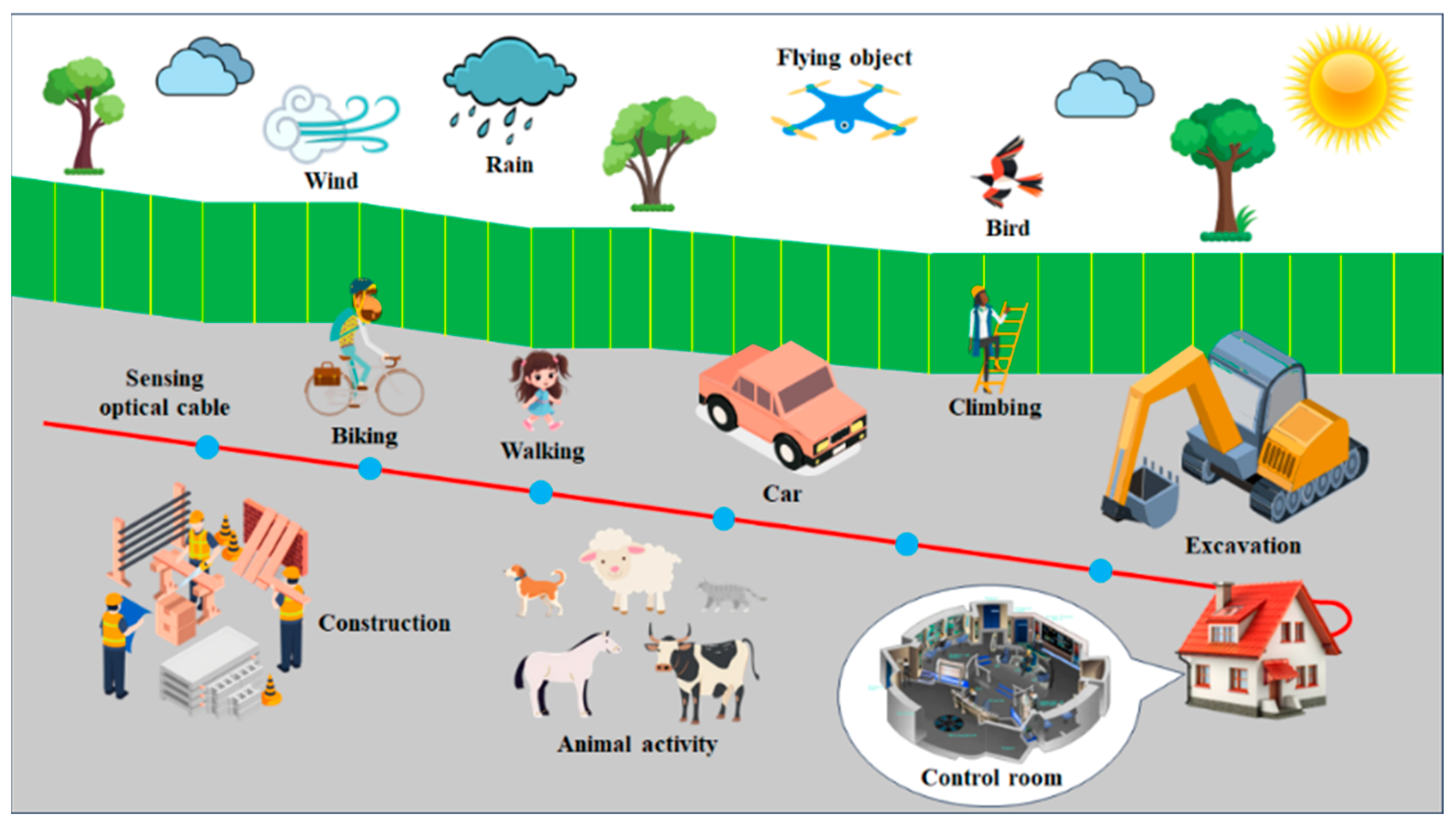
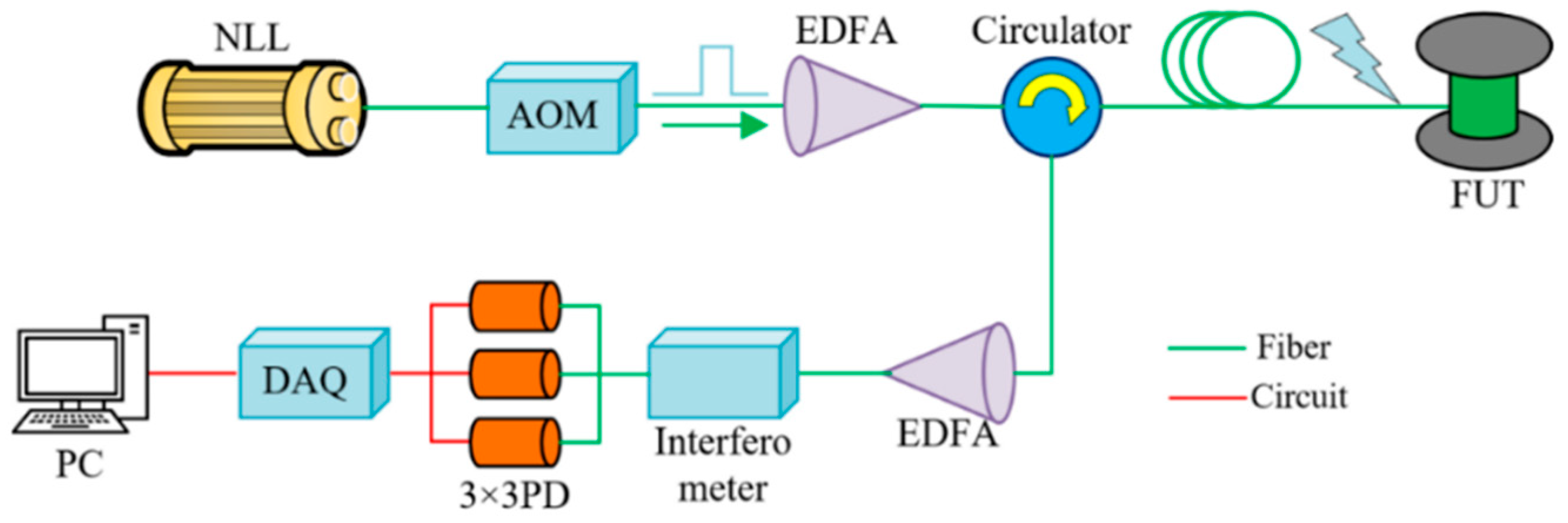
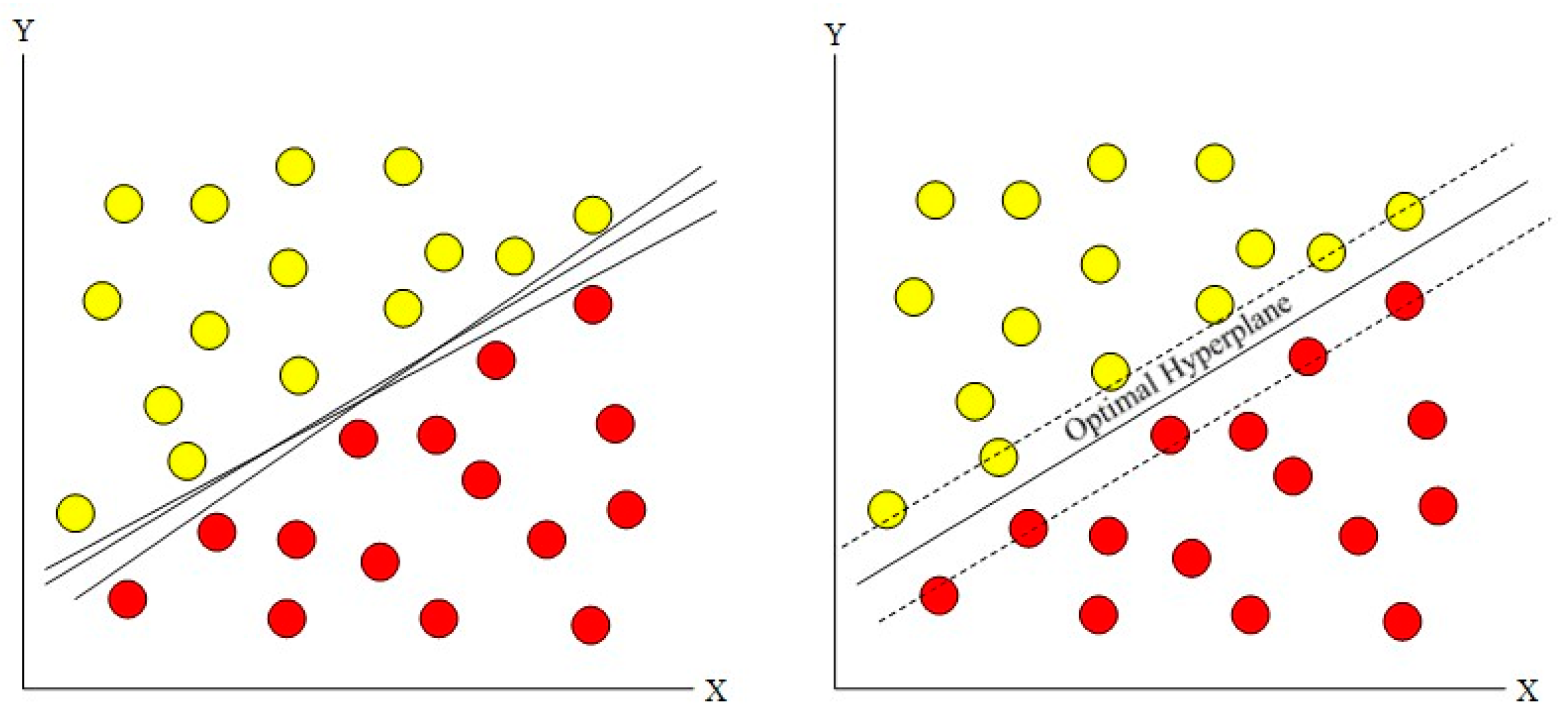

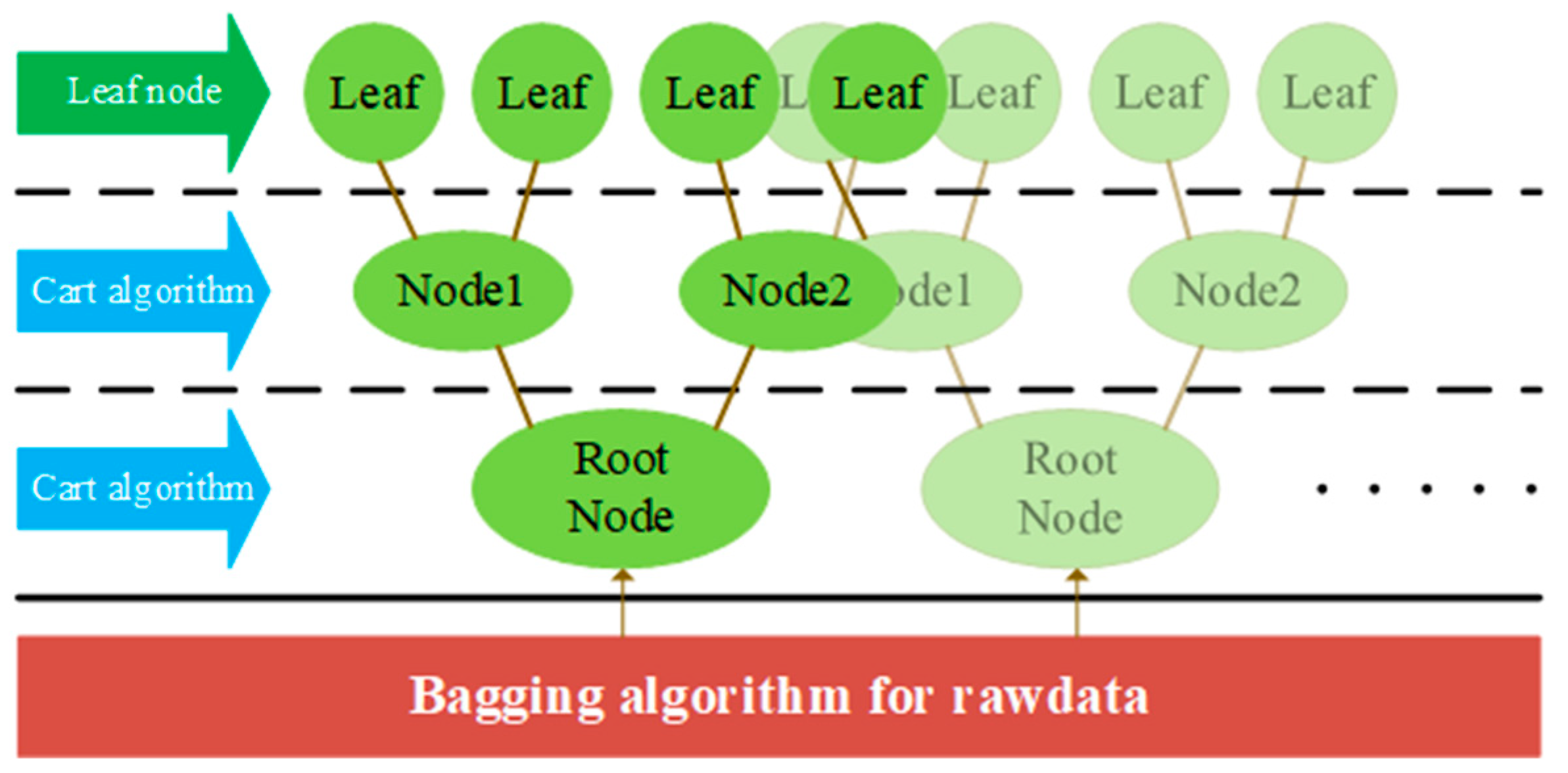
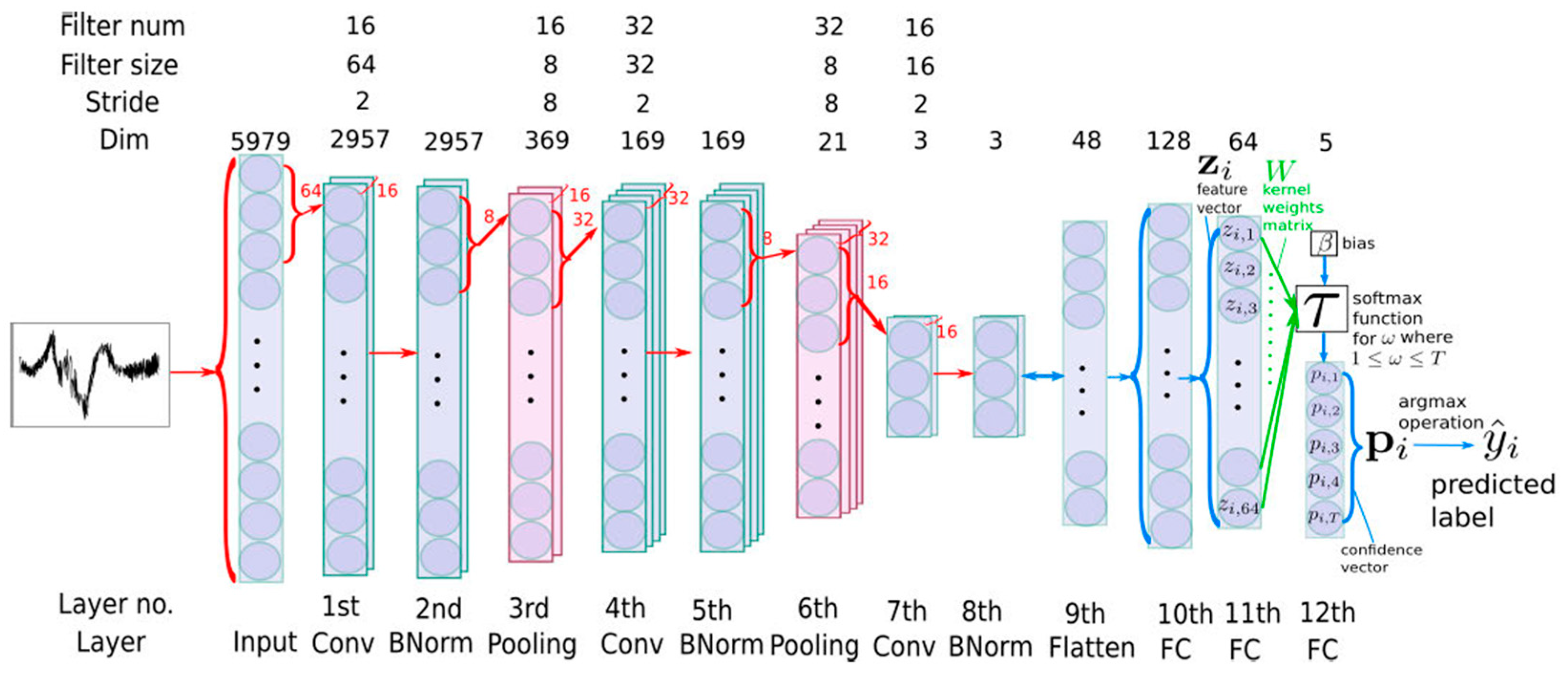
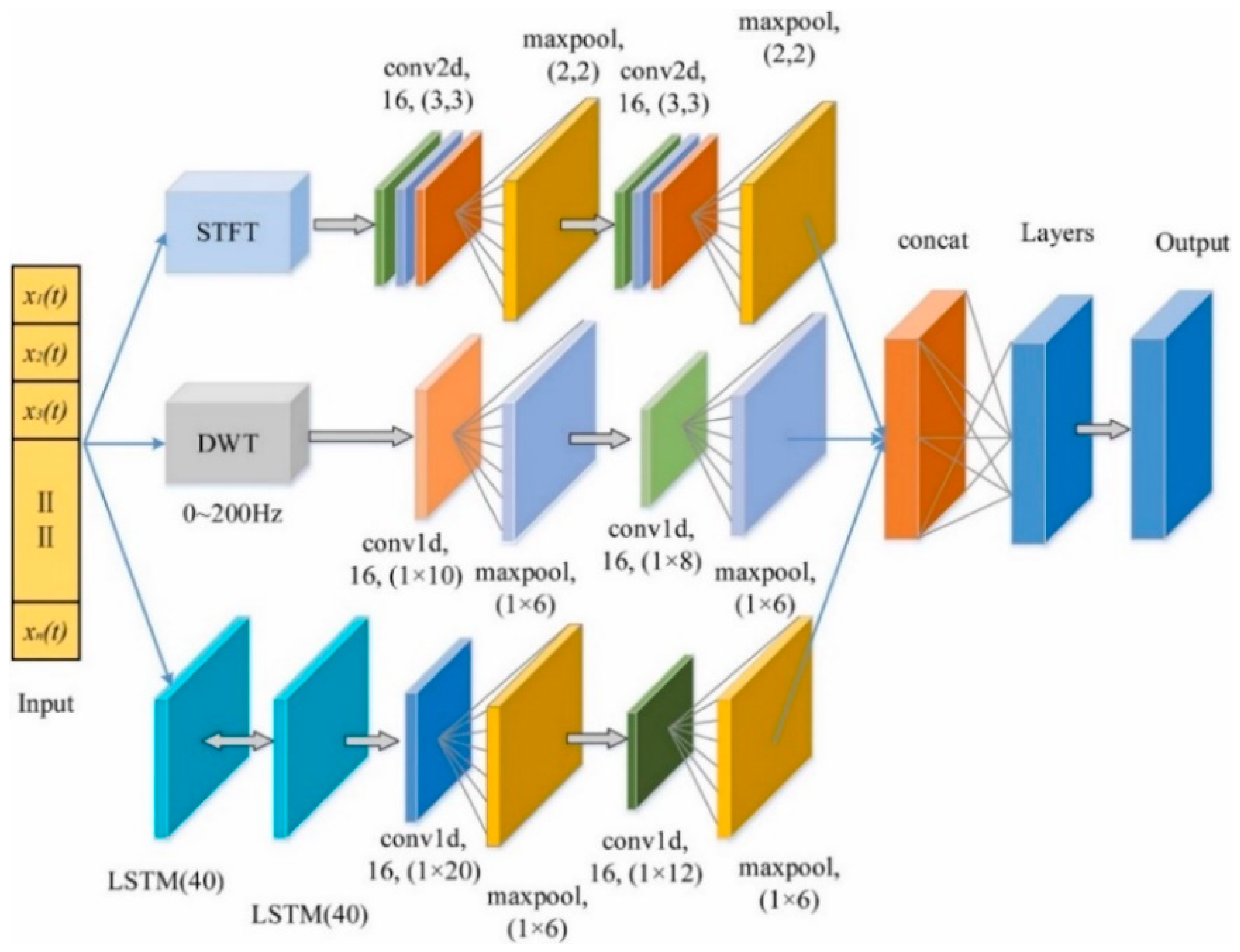
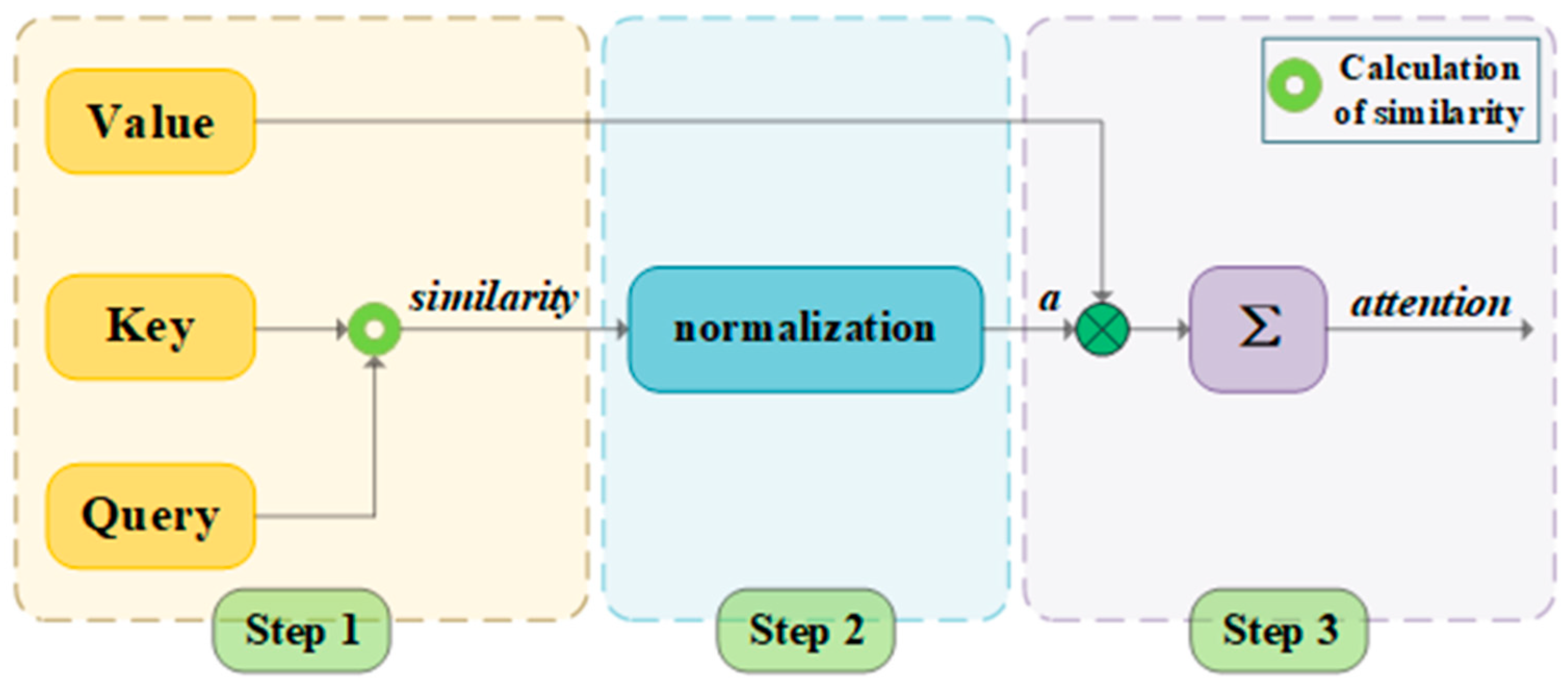
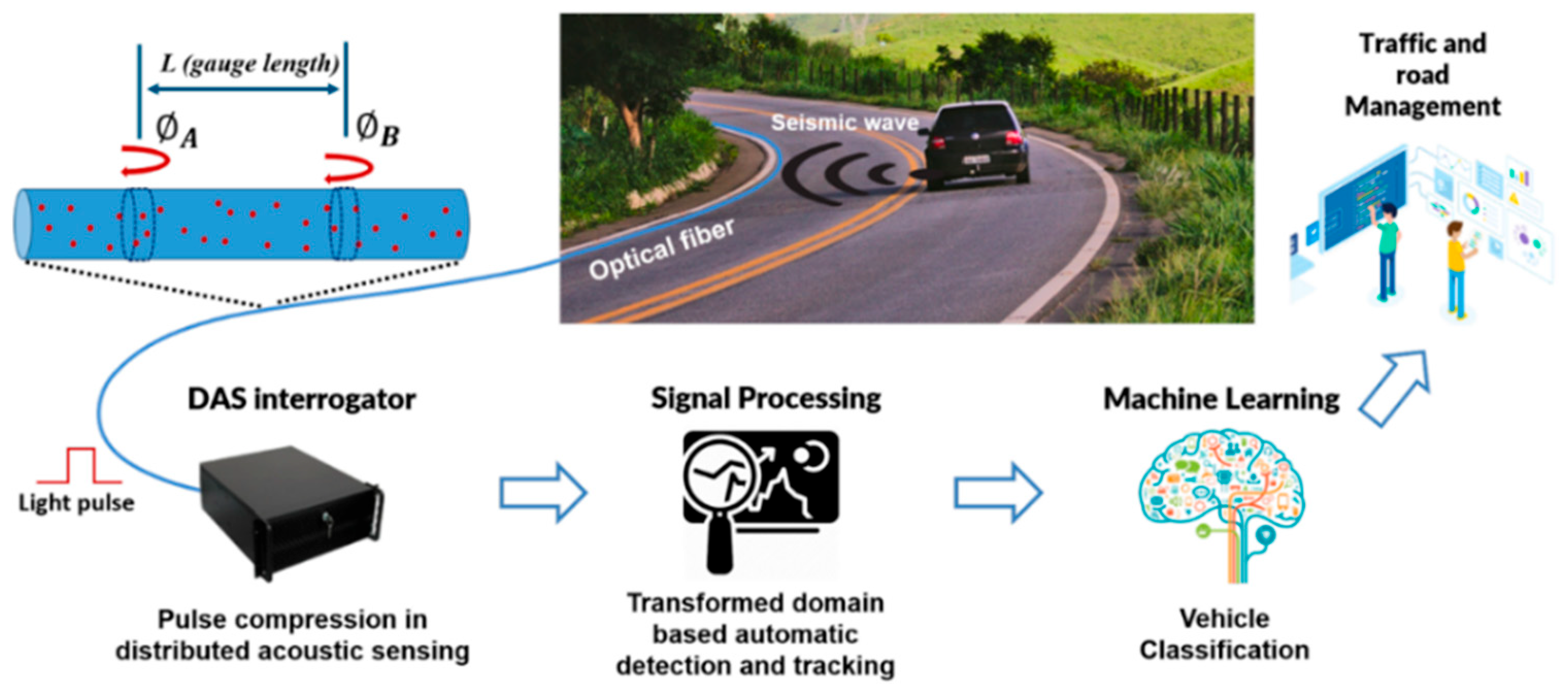
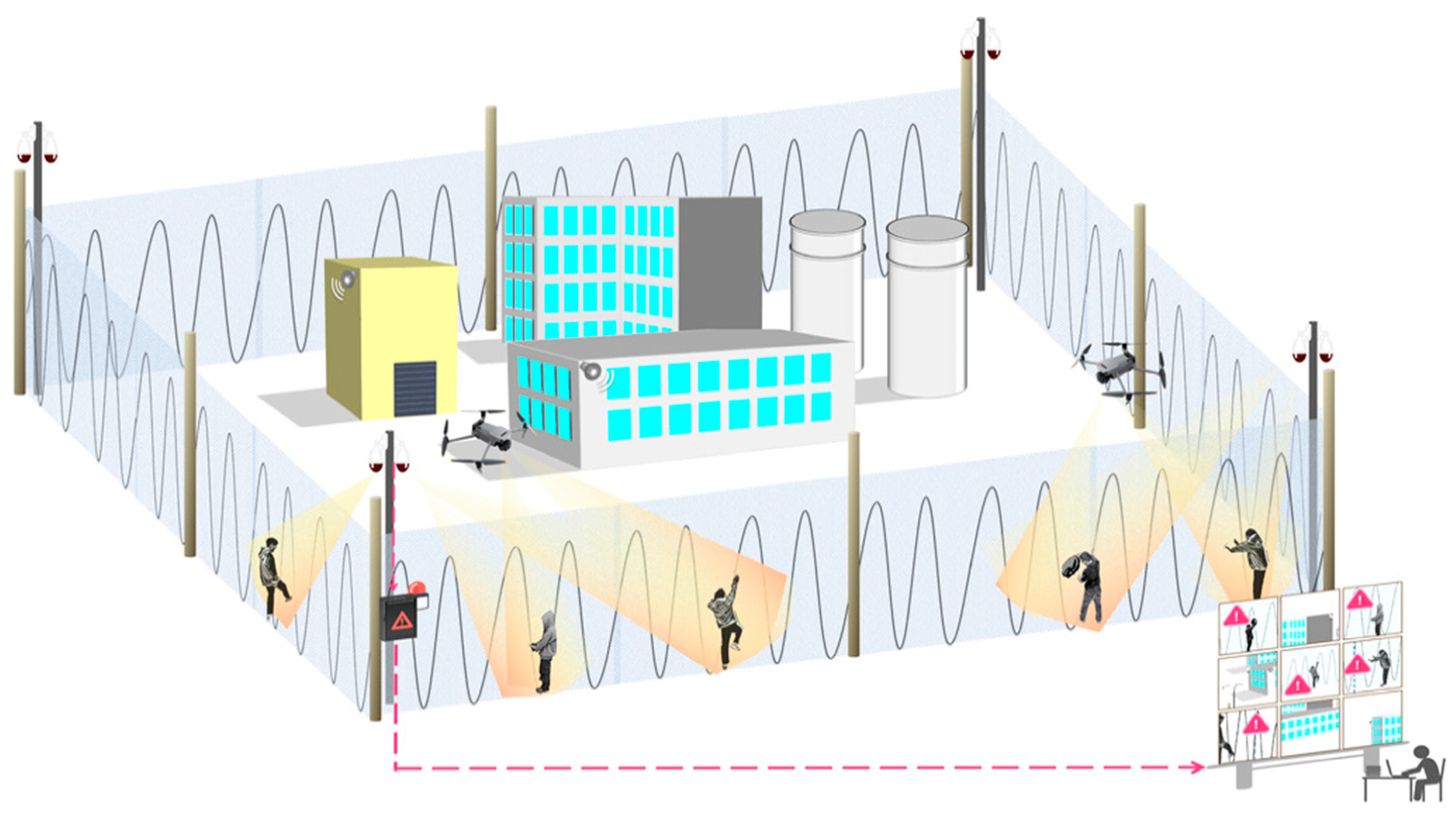
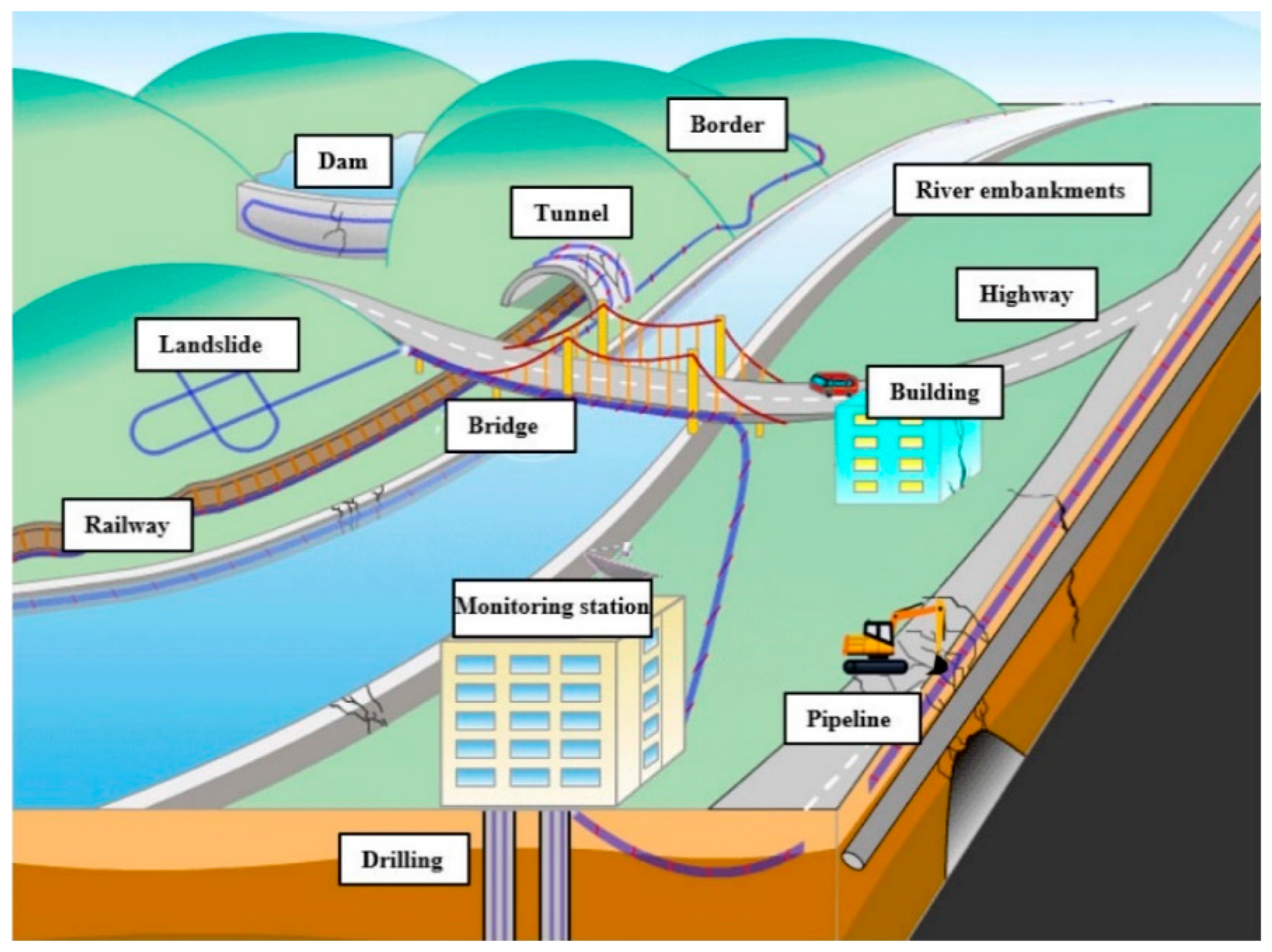
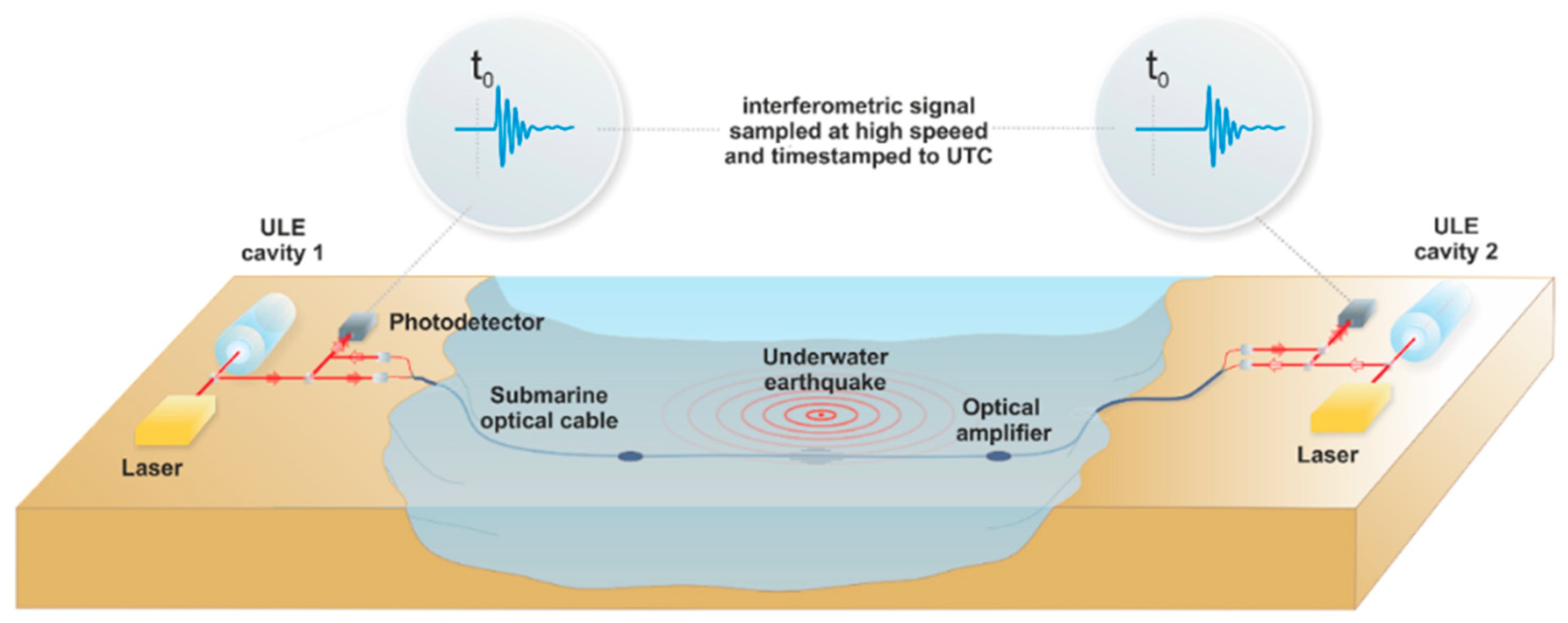

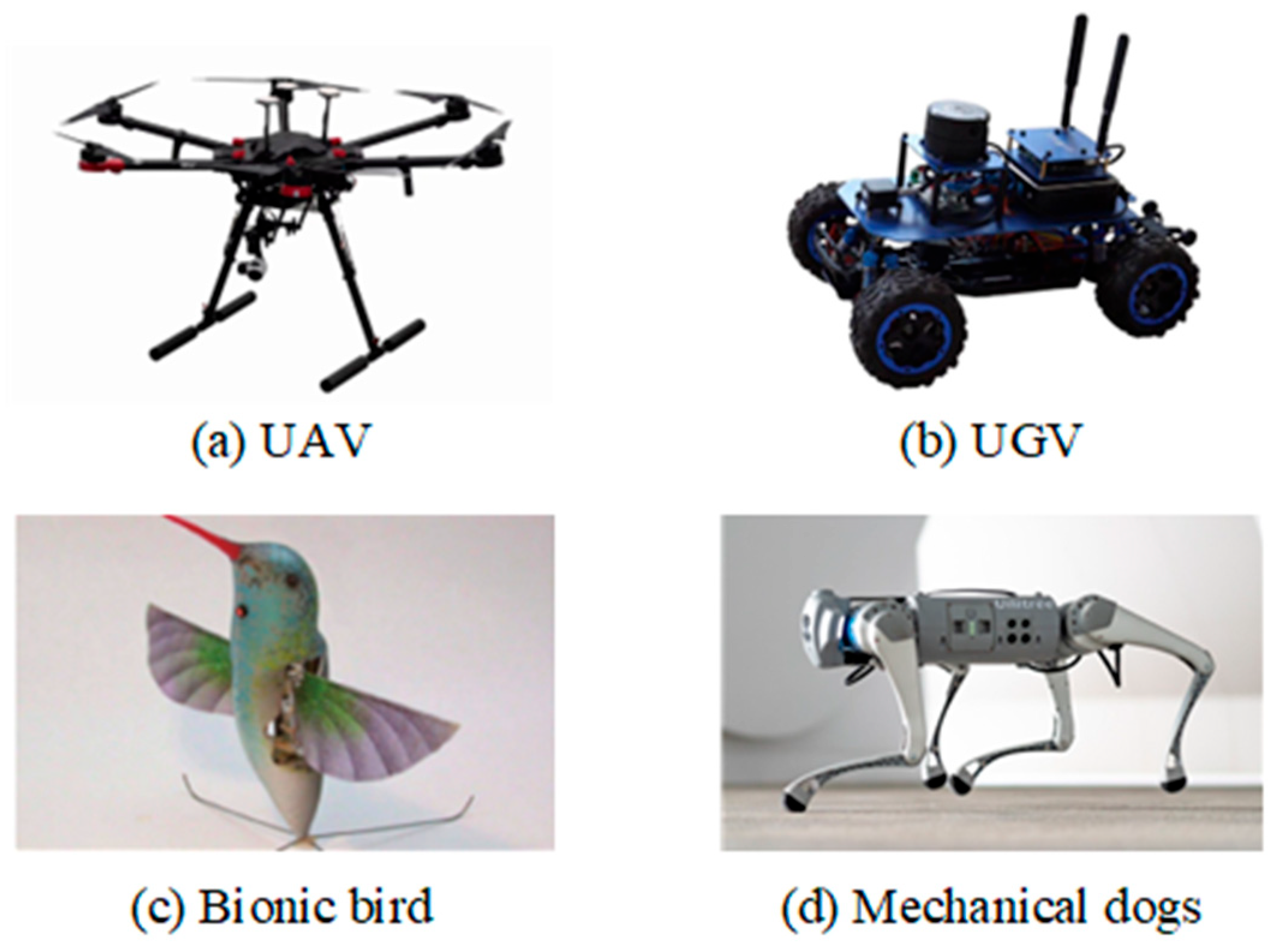
| Reference | Year | Method | Accuracy | Application Field |
|---|---|---|---|---|
| [49] | 2020 | SVM + Kalman Filter | >98% | Railway Monitoring |
| [50] | 2020 | LSVM + VMD | 75.2%/79.5% | Intrusion Detection |
| [51] | 2021 | SVM + Wavelet Denoising + Chebyshev Filter | >97% | Railway Monitoring |
| [52] | 2024 | SVM + CV | 99.62% | Pipeline Monitoring |
| [53] | 2019 | HMM + Knowledge Mining | 98.2% | Pipeline Monitoring |
| [54] | 2024 | HMM + Waveform Segmentation | 97.30% | Railway Safety |
| [55] | 2019 | RF | 96.58%/99.32% | - |
| [56] | 2021 | RF + EMD | 92.31% | Tunnel Monitoring |
| [57] | 2024 | RF + Matched Filter + Root Mean Square | 98% | Traffic Monitoring |
| [58] | 2022 | IF | >90% | Infrastructure Monitoring |
| [59] | 2024 | Logistic Regression | 93.4% | Pipeline Monitoring |
| [60] | 2017 | MLP + GMM | 54.92%/69.7% | Pipeline Monitoring |
| [61] | 2020 | DBSCAN Clustering | - | Tunnel Monitoring |
| [62] | 2025 | Principal Eigenvalue Analysis + FastICA | - | - |
| Reference | Year | Method | Accuracy | Application Field |
|---|---|---|---|---|
| [63] | 2021 | CNN | 98.04% | Railway Safety |
| [64] | 2021 | IP-CNN | 88.2% | - |
| [65] | 2021 | FC-ANN + CNN + RNN | 96.94%/93.86% | Earthquake Monitoring |
| [66] | 2022 | CNN + Greedy Algorithm | 97.91% | Railway Safety |
| [67] | 2023 | 1-D CNN | >94% | Traffic Monitoring |
| [68] | 2024 | TFF-CNN | 99.30% | Intrusion Detection |
| [69] | 2024 | 1-D MFCNN + 1-D MFEWnet | 99.6% | Perimeter Security |
| [70] | 2024 | 3-D ACNN | 99.33% | - |
| [71] | 2023 | CEEMDAN-Permutation Entropy + RBF | 88.15% | Pipeline Monitoring |
| [72] | 2024 | STNet + SW | 96.9% | Intrusion Detection |
| [73] | 2024 | Multi-task Learning + CNN | >96% | Perimeter Security |
| [74] | 2024 | Faster R-CNN | 98.85% | Pipeline Monitoring |
| [75] | 2020 | YOLOv3 | >80% | Earthquake Monitoring |
| [76] | 2025 | YOLOv5-Break | 97.72% | Pipeline Monitoring |
| [77] | 2024 | YOLOv7 + CBAM | 99.7% | - |
| [78] | 2024 | YOLOv8 + CBAM | 97.78% | Perimeter Security |
| [79] | 2023 | YOLOX | 100% | Infrastructure Monitoring |
| [80] | 2020 | ConvLSTM + CNN | 90% | Railway Safety |
| [81] | 2020 | ConvLSTM + CNN | 85.6% | Railway Safety |
| [82] | 2023 | CNN + LSTM | 93.87% | - |
| [83] | 2019 | CLDNN | >97% | Pipeline Monitoring |
| [84] | 2024 | 1D CNN + Bi-LSTM | >94.5% | - |
| [85] | 2024 | CNN-LSTM-SW | 97% | Railway Safety |
| [86] | 2024 | LSTM + GRU | >93% | Railway Monitoring |
| [87] | 2024 | ConvLSTM | 72.8% | Human Flow Monitoring |
| [88] | 2023 | MS-CNN | 95.43% | Threat Event Detection |
| [89] | 2024 | DSAD + DSAD-VAE | 100% | Rail Safety |
| [90] | 2024 | CNN-LSTM-Self-Attention | 96.25% | Intrusion Detection |
| [91] | 2019 | SimGAN | 80.2% | - |
| [92] | 2022 | DAE | - | Traffic Management |
| [93] | 2023 | NAM-MAE | 96.6134% | Peripheral Security |
| [94] | 2024 | CNN + VQ-VAE | 95% | Natural Disaster Monitoring |
| Reference | Year | Method | Accuracy | Application Field |
|---|---|---|---|---|
| [95] | 2019 | CNN + K-means | <90% | Pipeline Monitoring |
| [96] | 2020 | CNN + SVM | 94.17% | - |
| [97] | 2021 | CNN + SVM + RF | >99% | Pipeline Monitoring |
| [98] | 2022 | Decision Tree + BP Neural Network | 97.6% | Perimeter Security |
| [99] | 2023 | Convolutional AE + Clustering | 91.5% | Railway Safety |
| [100] | 2023 | Meta-learning + Wide ResNet | 97.65%/98.80%/98.85% | Infrastructure Monitoring |
| [101] | 2020 | MSCNN + Prototype Learning | 84.67% | Perimeter Security |
| [102] | 2025 | YOLOv7 tiny + Greedy Algorithm | 81.8%/60.4% | Perimeter Security |
| [103] | 2023 | U-Net + FBE | - | Pipeline Monitoring |
| Dataset Name | Year | Application Field | Events (Quantity) | Data Type | Key Features |
|---|---|---|---|---|---|
| Railway Track Performance [114] | 2020 | Railway monitoring | Train loads, track strain, track displacement, and bending (~5 GB) | Time-series strain | 10 km fiber, vibration events |
| PubDAS [150] | 2023 | Geosciences | Urban centers, underground mining areas, submarine earthquakes, anthropogenic noise, and natural phenomena (~90 TB) | Seismic waveforms | 8 global field experiments |
| Brady Hot Springs [151] | 2018 | Geothermal monitoring | Earthquakes: 4 + main (~90 TB) | Temperature/Strain | 15 day continuous DAS + DTS |
| Φ-OTDR Events [152] | 2023 | Event classification | Background noise (3094), excavation (2512), tapping (2530), watering (2298), shaking (2728), and walking (2450) (15 GB) | Time-space matrices | Labeled human/mechanical activities |
| DAShip [153] | 2025 | Maritime security | Ship passages (55,875) and ship instances (18,625) | Time-space images | 3 TB total, AIS-correlated |
| Intelligent Traffic DAS [154] | 2024 | Traffic monitoring | Vehicle patterns and noise interference (200 sample pairs) | Spectrograms | Paired raw/processed data |
| Subsea Cable [155] | 2019 | Submarine cables | Cable impacts and cyclic cable loading (45 GB) | Vibration signals | 131 km fiber span |
Disclaimer/Publisher’s Note: The statements, opinions and data contained in all publications are solely those of the individual author(s) and contributor(s) and not of MDPI and/or the editor(s). MDPI and/or the editor(s) disclaim responsibility for any injury to people or property resulting from any ideas, methods, instructions or products referred to in the content. |
© 2025 by the authors. Licensee MDPI, Basel, Switzerland. This article is an open access article distributed under the terms and conditions of the Creative Commons Attribution (CC BY) license (https://creativecommons.org/licenses/by/4.0/).
Share and Cite
Wu, D.; Liang, Q.-Q.; Hu, B.-X.; Zhang, Z.-T.; Wang, X.-F.; Jiang, J.-J.; Yi, G.-W.; Zeng, H.-Y.; Hu, J.-Y.; Yu, Y.; et al. Research Progress of Event Intelligent Perception Based on DAS. Sensors 2025, 25, 5052. https://doi.org/10.3390/s25165052
Wu D, Liang Q-Q, Hu B-X, Zhang Z-T, Wang X-F, Jiang J-J, Yi G-W, Zeng H-Y, Hu J-Y, Yu Y, et al. Research Progress of Event Intelligent Perception Based on DAS. Sensors. 2025; 25(16):5052. https://doi.org/10.3390/s25165052
Chicago/Turabian StyleWu, Di, Qing-Quan Liang, Bing-Xuan Hu, Ze-Ting Zhang, Xue-Feng Wang, Jia-Jun Jiang, Gao-Wei Yi, Hong-Yao Zeng, Jin-Yuan Hu, Yang Yu, and et al. 2025. "Research Progress of Event Intelligent Perception Based on DAS" Sensors 25, no. 16: 5052. https://doi.org/10.3390/s25165052
APA StyleWu, D., Liang, Q.-Q., Hu, B.-X., Zhang, Z.-T., Wang, X.-F., Jiang, J.-J., Yi, G.-W., Zeng, H.-Y., Hu, J.-Y., Yu, Y., & Zhang, Z.-R. (2025). Research Progress of Event Intelligent Perception Based on DAS. Sensors, 25(16), 5052. https://doi.org/10.3390/s25165052









